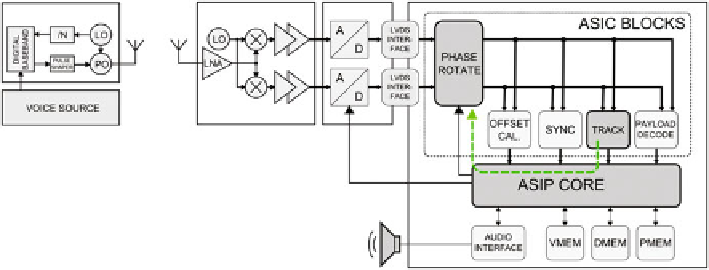Biomedical Engineering Reference
In-Depth Information
Fig. 7
Behind-the-ear audio streaming
externally. The LO carrier is generated on-chip (as introduced in the following sec-
tion) and is calibrated for the carrier frequency, while left free running during the
operation.
Design of the IR-UWB system
Many previous work about IR-UWB on the lower RF band (3
5 GHz) or sub-
GHz range [
4
-
7
] has been published. However, such band selection can't provide
worldwide coverage, neither standard compliant. Differently, the work presented
here provides the first complete IR-UWB system, including the fully integrated
transmitter, a receiver front end, an analog to digital converter (ADC) board [
8
] and
the field programmable gate arrays (FPGA)-based receiver digital baseband for full
data synchronization and data processing. The entire system is catered for around-
the-body data streaming. However, with minor adaption on the digital baseband, it
can also be implemented in accurate localization system (Fig.
7
).
The main design challenges for the IR-UWB system (especially the RF frontend)
are the low power consumption, large signal bandwidth, and fast startup time. The
noise and the linearity requirements are relatively relaxed as compared to the conven-
tional radio systems. Therefore, low power can be achieved partially as a trades-off
with noise and linearity performance. Furthermore, the average power consumption
can be reduced by duty-cycling the various components. The large signal bandwidth
(500 MHz) increases the design difficulties at the input/output matching, and more
stringently, at the variable-gain-amplifier (VGA)/analog filters, ADCs, and the digi-
tal baseband. Last, the startup time of each block is also a critical design parameter,
since the power consumption during this time becomes the overhead of the total
power consumption. The RC combination usually implemented in the biasing circuit
becomes the bottleneck to shorten the startup time. All these design issues will be
addressed in the following sections with details, together with the design choice,
circuit techniques, and measurement results.
∼

Search WWH ::

Custom Search